King's Own Institute: FIN700 Financial Management Assignment Solution
VerifiedAdded on 2023/03/17
|13
|1751
|94
Homework Assignment
AI Summary
This assignment solution addresses several key concepts in financial management. Question 1 focuses on dividend payout ratios and income calculations for a shareholder, involving profit after tax, dividend payments, and loan calculations. Question 2 delves into loan amortization, calculating new monthly repayments and the extra period added to a loan term due to interest rate changes. Question 3 explores present value calculations, comparing different investment options based on expected cash flows and required returns. Question 4 addresses bond pricing, calculating bond prices with varying maturities and discussing the sensitivity of bond prices to interest rate changes. Question 5 covers the Gordon growth model, calculating the value of a share based on expected dividends and growth rates. Question 6 involves annual equivalent cost (AEC) analysis, comparing two quotes for an asset purchase. Finally, Question 7 analyzes a project's feasibility, considering sunk costs, incremental cash flows, payback period, net present value (NPV), and present value of index to determine whether a project should be undertaken.
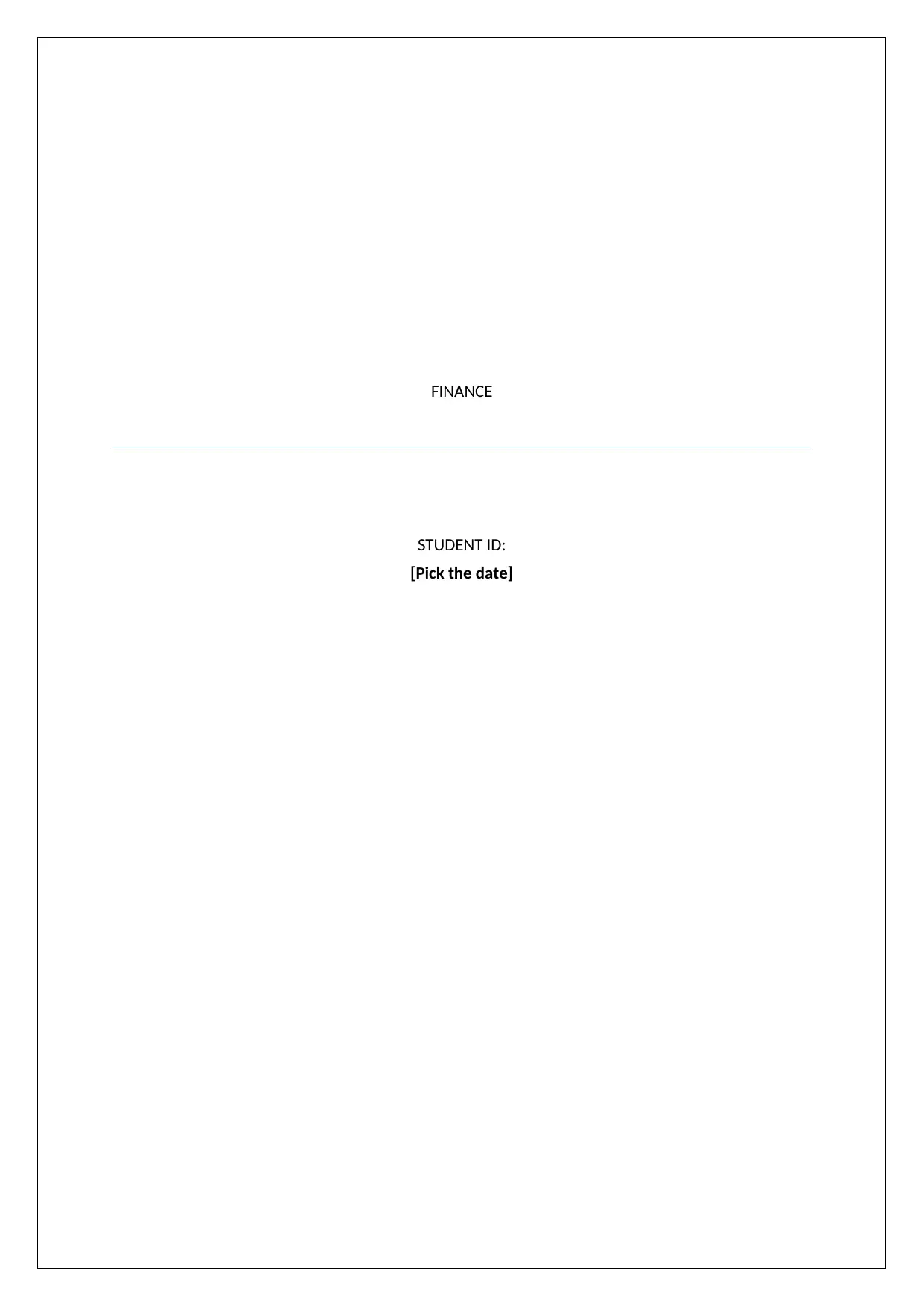
FINANCE
STUDENT ID:
[Pick the date]
STUDENT ID:
[Pick the date]
Paraphrase This Document
Need a fresh take? Get an instant paraphrase of this document with our AI Paraphraser
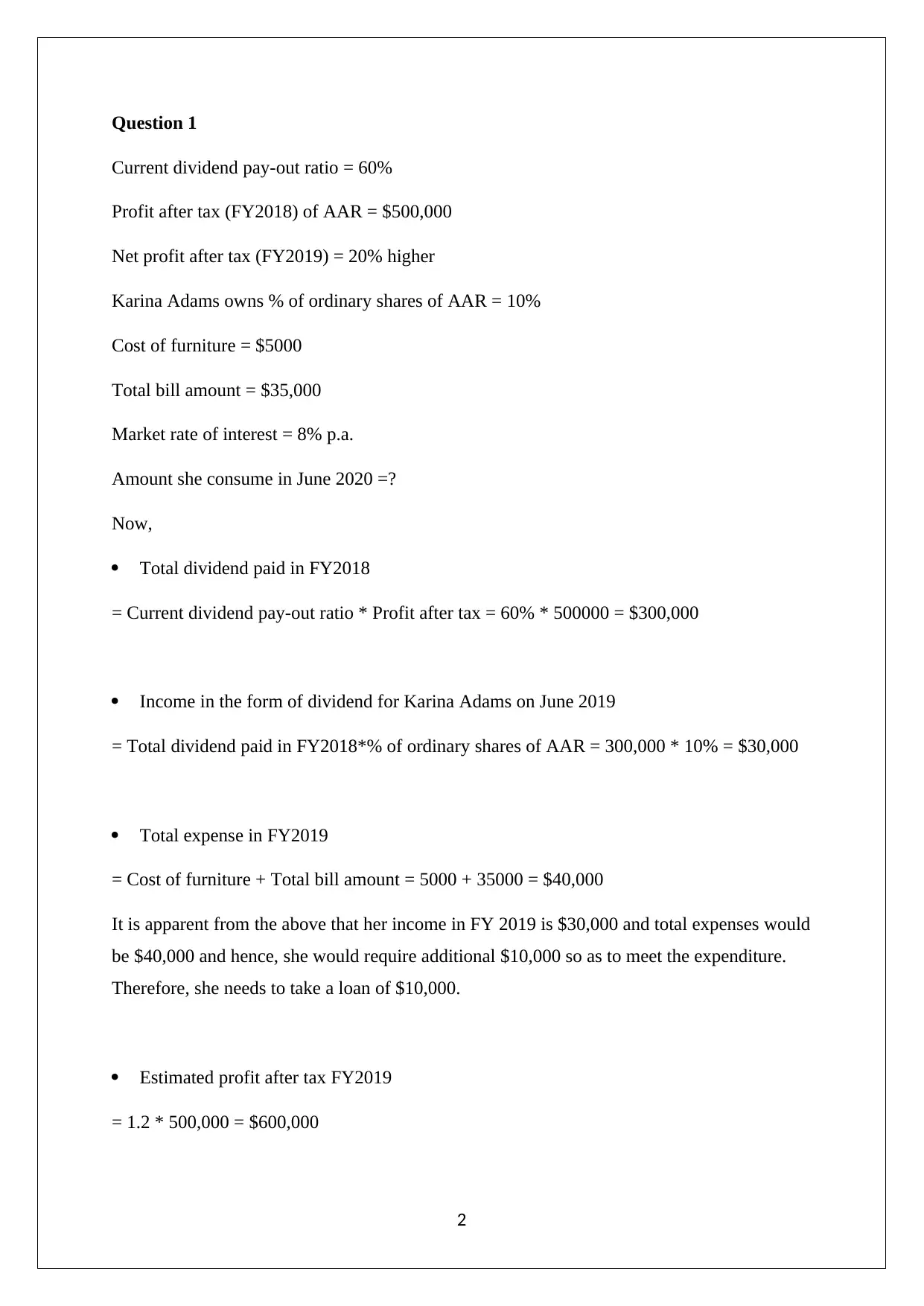
Question 1
Current dividend pay-out ratio = 60%
Profit after tax (FY2018) of AAR = $500,000
Net profit after tax (FY2019) = 20% higher
Karina Adams owns % of ordinary shares of AAR = 10%
Cost of furniture = $5000
Total bill amount = $35,000
Market rate of interest = 8% p.a.
Amount she consume in June 2020 =?
Now,
Total dividend paid in FY2018
= Current dividend pay-out ratio * Profit after tax = 60% * 500000 = $300,000
Income in the form of dividend for Karina Adams on June 2019
= Total dividend paid in FY2018*% of ordinary shares of AAR = 300,000 * 10% = $30,000
Total expense in FY2019
= Cost of furniture + Total bill amount = 5000 + 35000 = $40,000
It is apparent from the above that her income in FY 2019 is $30,000 and total expenses would
be $40,000 and hence, she would require additional $10,000 so as to meet the expenditure.
Therefore, she needs to take a loan of $10,000.
Estimated profit after tax FY2019
= 1.2 * 500,000 = $600,000
2
Current dividend pay-out ratio = 60%
Profit after tax (FY2018) of AAR = $500,000
Net profit after tax (FY2019) = 20% higher
Karina Adams owns % of ordinary shares of AAR = 10%
Cost of furniture = $5000
Total bill amount = $35,000
Market rate of interest = 8% p.a.
Amount she consume in June 2020 =?
Now,
Total dividend paid in FY2018
= Current dividend pay-out ratio * Profit after tax = 60% * 500000 = $300,000
Income in the form of dividend for Karina Adams on June 2019
= Total dividend paid in FY2018*% of ordinary shares of AAR = 300,000 * 10% = $30,000
Total expense in FY2019
= Cost of furniture + Total bill amount = 5000 + 35000 = $40,000
It is apparent from the above that her income in FY 2019 is $30,000 and total expenses would
be $40,000 and hence, she would require additional $10,000 so as to meet the expenditure.
Therefore, she needs to take a loan of $10,000.
Estimated profit after tax FY2019
= 1.2 * 500,000 = $600,000
2
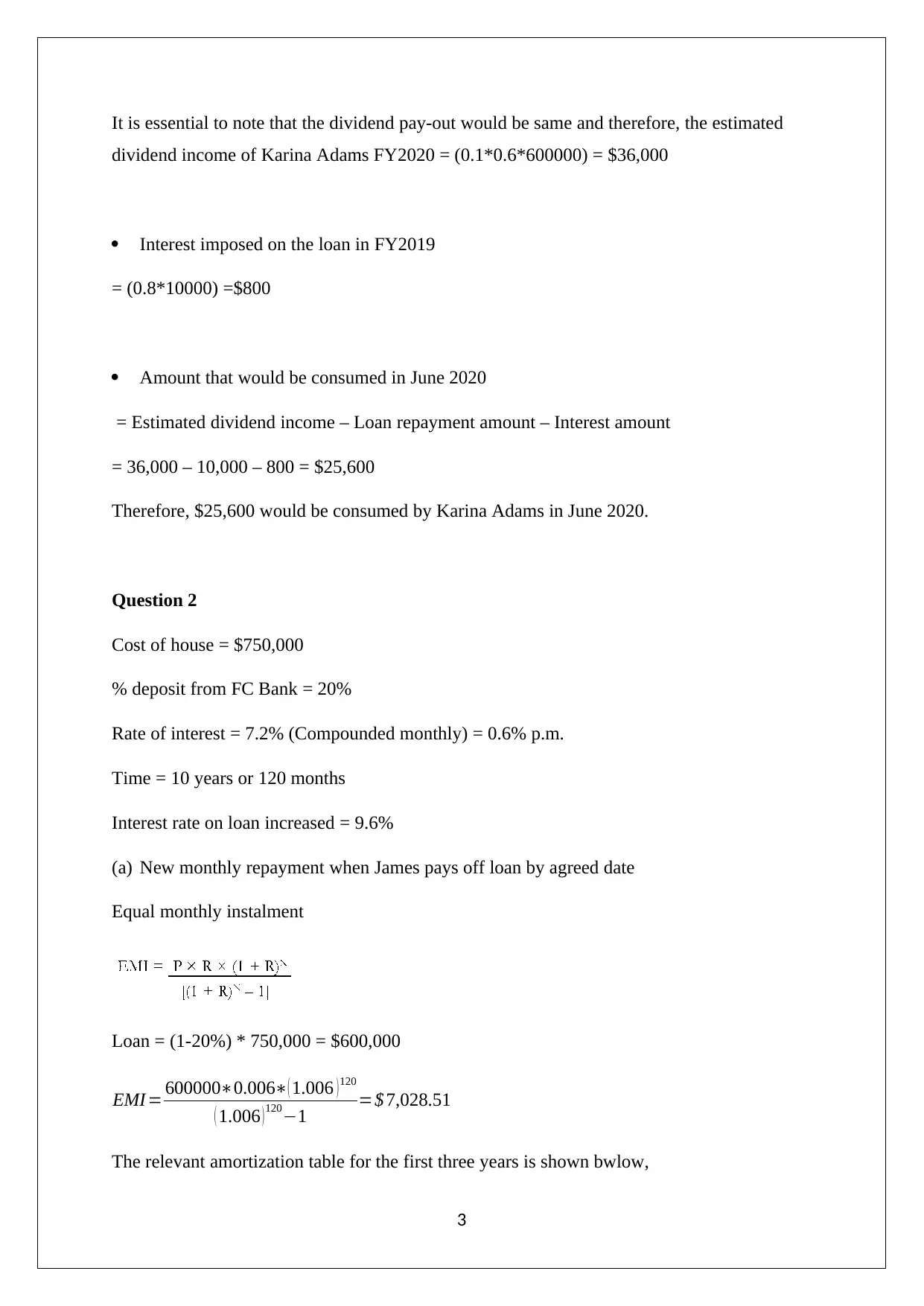
It is essential to note that the dividend pay-out would be same and therefore, the estimated
dividend income of Karina Adams FY2020 = (0.1*0.6*600000) = $36,000
Interest imposed on the loan in FY2019
= (0.8*10000) =$800
Amount that would be consumed in June 2020
= Estimated dividend income – Loan repayment amount – Interest amount
= 36,000 – 10,000 – 800 = $25,600
Therefore, $25,600 would be consumed by Karina Adams in June 2020.
Question 2
Cost of house = $750,000
% deposit from FC Bank = 20%
Rate of interest = 7.2% (Compounded monthly) = 0.6% p.m.
Time = 10 years or 120 months
Interest rate on loan increased = 9.6%
(a) New monthly repayment when James pays off loan by agreed date
Equal monthly instalment
Loan = (1-20%) * 750,000 = $600,000
EMI= 600000∗0.006∗( 1.006 )120
( 1.006 )120−1 =$ 7,028.51
The relevant amortization table for the first three years is shown bwlow,
3
dividend income of Karina Adams FY2020 = (0.1*0.6*600000) = $36,000
Interest imposed on the loan in FY2019
= (0.8*10000) =$800
Amount that would be consumed in June 2020
= Estimated dividend income – Loan repayment amount – Interest amount
= 36,000 – 10,000 – 800 = $25,600
Therefore, $25,600 would be consumed by Karina Adams in June 2020.
Question 2
Cost of house = $750,000
% deposit from FC Bank = 20%
Rate of interest = 7.2% (Compounded monthly) = 0.6% p.m.
Time = 10 years or 120 months
Interest rate on loan increased = 9.6%
(a) New monthly repayment when James pays off loan by agreed date
Equal monthly instalment
Loan = (1-20%) * 750,000 = $600,000
EMI= 600000∗0.006∗( 1.006 )120
( 1.006 )120−1 =$ 7,028.51
The relevant amortization table for the first three years is shown bwlow,
3
⊘ This is a preview!⊘
Do you want full access?
Subscribe today to unlock all pages.

Trusted by 1+ million students worldwide
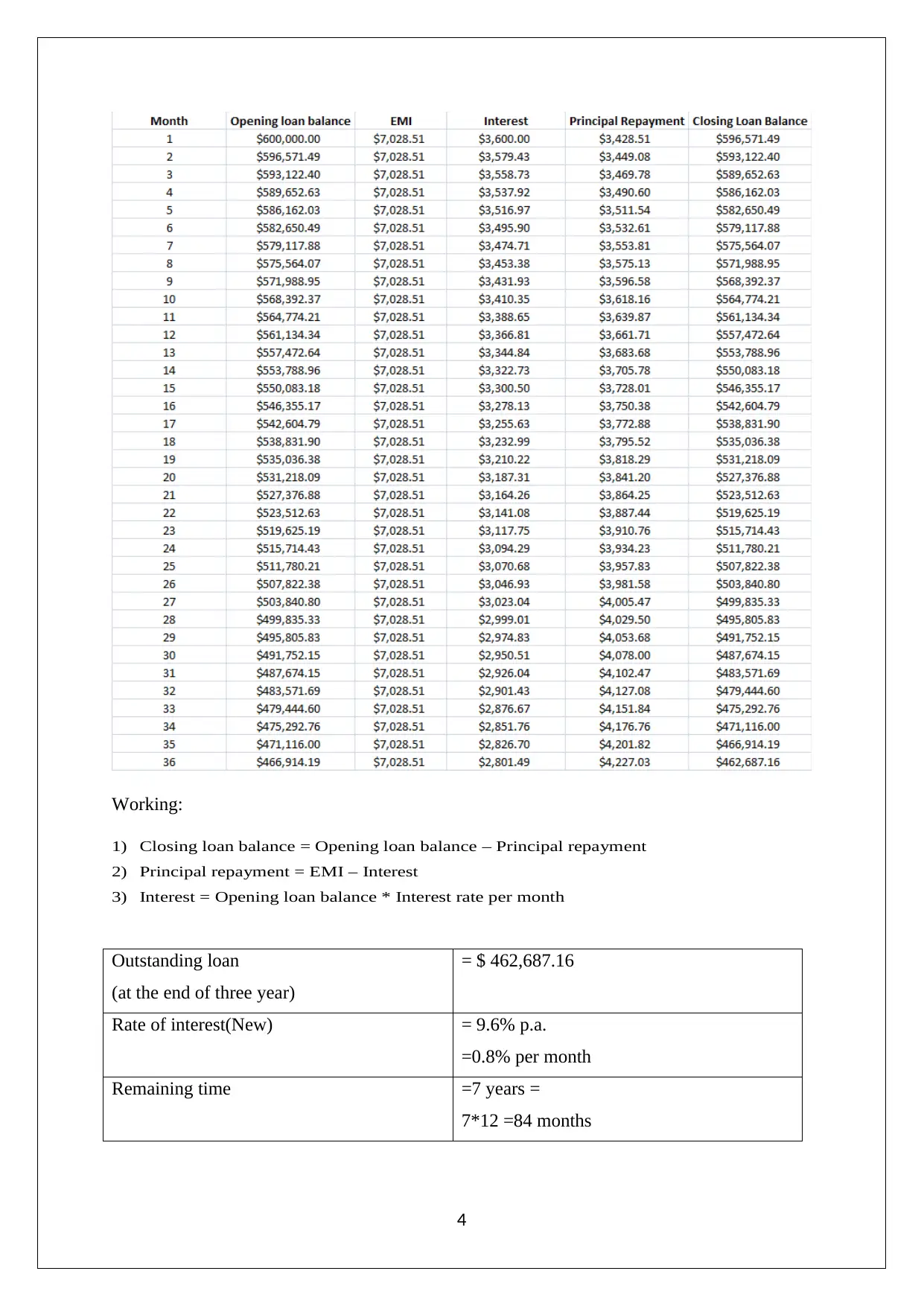
Working:
1) Closing loan balance = Opening loan balance – Principal repayment
2) Principal repayment = EMI – Interest
3) Interest = Opening loan balance * Interest rate per month
Outstanding loan
(at the end of three year)
= $ 462,687.16
Rate of interest(New) = 9.6% p.a.
=0.8% per month
Remaining time =7 years =
7*12 =84 months
4
1) Closing loan balance = Opening loan balance – Principal repayment
2) Principal repayment = EMI – Interest
3) Interest = Opening loan balance * Interest rate per month
Outstanding loan
(at the end of three year)
= $ 462,687.16
Rate of interest(New) = 9.6% p.a.
=0.8% per month
Remaining time =7 years =
7*12 =84 months
4
Paraphrase This Document
Need a fresh take? Get an instant paraphrase of this document with our AI Paraphraser

EMI (new)= 462687.16∗0.008∗( 1.008 )84
( 1.008 )84−1 =$ 7585.87
(b) Computation of extra period added to term of loan
P = $ 462,687.16
EMI $7058.21
Interest rate (New) = 9.6% p.a.
=0.8% per month
7058.21= 462687.16∗0.008∗( 1.008 )N
( 1.008 ) N−1
N=94 months
It is essential to note that the three years had passed which means the pending loan amount
would be discharged in 84 months without any further increase in interest rate and thus, the
extra payment needed 10 months (94 months -84 months).
Question 3
(a) Present value of payment
After required return = $300,000 in a year (6th year onwards)
Expected amount received (Inflows)= $120,000 (in year 4) and $220,000 (in year 5)
Required return = 10% p.a.
PV = FV
( 1+ R ) N =120000
1.14 + 220000
1.15 + 300000
0.1∗1.15
PV =$ 2,081,328
(b) Present value of perpetuity that will start paying two years from now
¿ 220000
(0.1)∗(1.1)2 =$ 1,818,182
5
( 1.008 )84−1 =$ 7585.87
(b) Computation of extra period added to term of loan
P = $ 462,687.16
EMI $7058.21
Interest rate (New) = 9.6% p.a.
=0.8% per month
7058.21= 462687.16∗0.008∗( 1.008 )N
( 1.008 ) N−1
N=94 months
It is essential to note that the three years had passed which means the pending loan amount
would be discharged in 84 months without any further increase in interest rate and thus, the
extra payment needed 10 months (94 months -84 months).
Question 3
(a) Present value of payment
After required return = $300,000 in a year (6th year onwards)
Expected amount received (Inflows)= $120,000 (in year 4) and $220,000 (in year 5)
Required return = 10% p.a.
PV = FV
( 1+ R ) N =120000
1.14 + 220000
1.15 + 300000
0.1∗1.15
PV =$ 2,081,328
(b) Present value of perpetuity that will start paying two years from now
¿ 220000
(0.1)∗(1.1)2 =$ 1,818,182
5
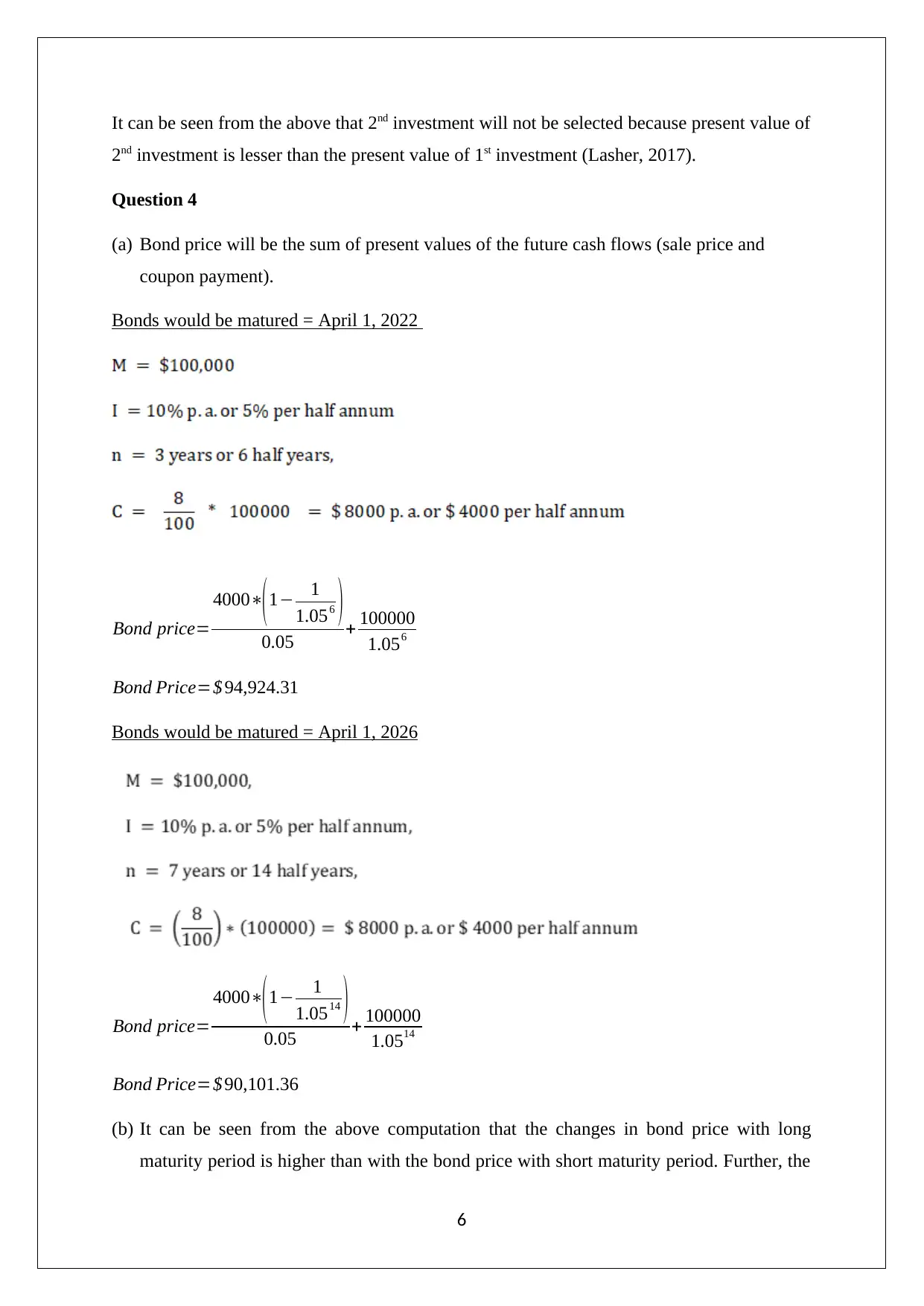
It can be seen from the above that 2nd investment will not be selected because present value of
2nd investment is lesser than the present value of 1st investment (Lasher, 2017).
Question 4
(a) Bond price will be the sum of present values of the future cash flows (sale price and
coupon payment).
Bonds would be matured = April 1, 2022
Bond price=
4000∗
(1− 1
1.056 )
0.05 + 100000
1.056
Bond Price=$ 94,924.31
Bonds would be matured = April 1, 2026
Bond price=
4000∗
(1− 1
1.0514 )
0.05 + 100000
1.0514
Bond Price=$ 90,101.36
(b) It can be seen from the above computation that the changes in bond price with long
maturity period is higher than with the bond price with short maturity period. Further, the
6
2nd investment is lesser than the present value of 1st investment (Lasher, 2017).
Question 4
(a) Bond price will be the sum of present values of the future cash flows (sale price and
coupon payment).
Bonds would be matured = April 1, 2022
Bond price=
4000∗
(1− 1
1.056 )
0.05 + 100000
1.056
Bond Price=$ 94,924.31
Bonds would be matured = April 1, 2026
Bond price=
4000∗
(1− 1
1.0514 )
0.05 + 100000
1.0514
Bond Price=$ 90,101.36
(b) It can be seen from the above computation that the changes in bond price with long
maturity period is higher than with the bond price with short maturity period. Further, the
6
⊘ This is a preview!⊘
Do you want full access?
Subscribe today to unlock all pages.

Trusted by 1+ million students worldwide
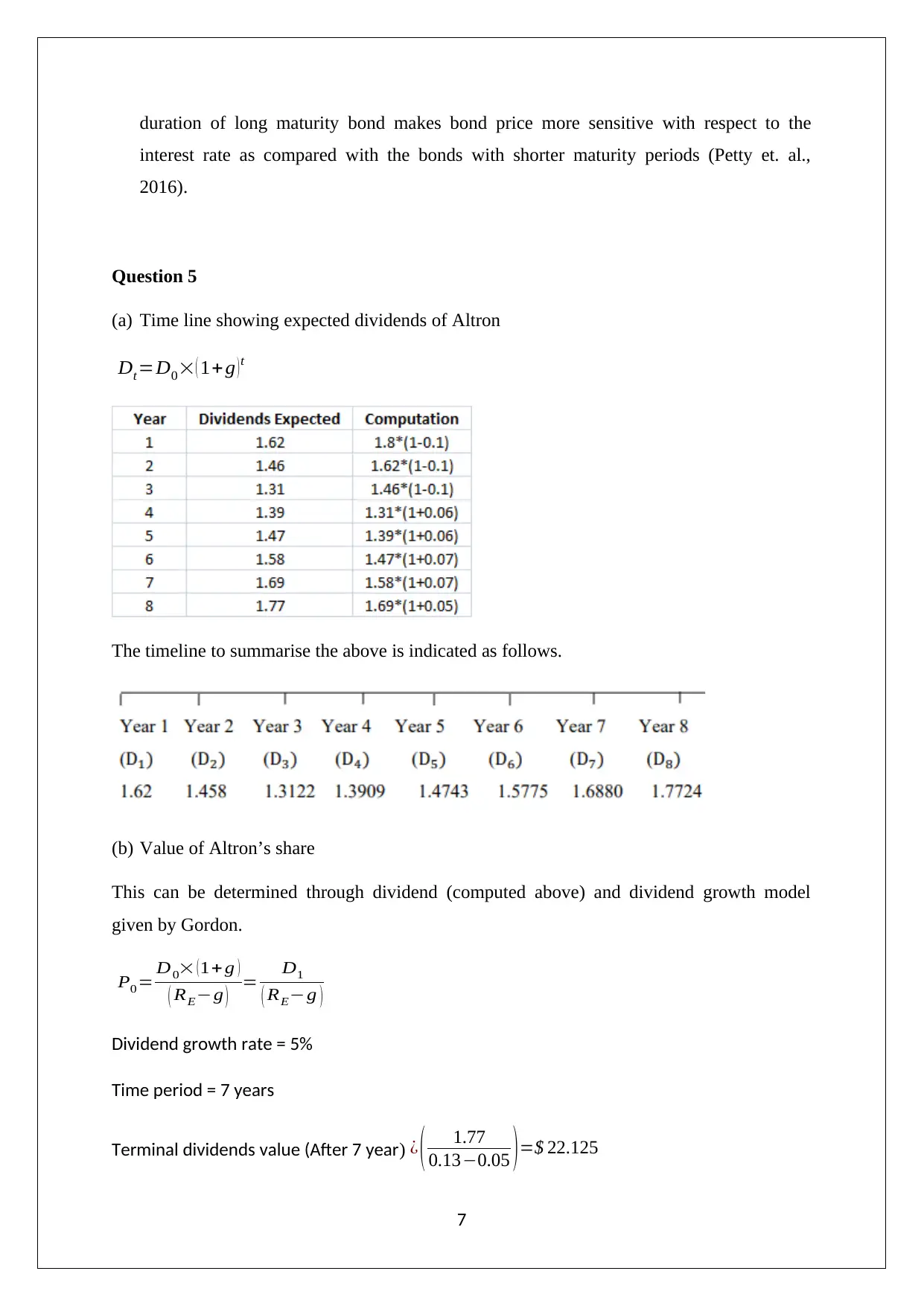
duration of long maturity bond makes bond price more sensitive with respect to the
interest rate as compared with the bonds with shorter maturity periods (Petty et. al.,
2016).
Question 5
(a) Time line showing expected dividends of Altron
Dt=D0× ( 1+g ) t
The timeline to summarise the above is indicated as follows.
(b) Value of Altron’s share
This can be determined through dividend (computed above) and dividend growth model
given by Gordon.
P0= D0× ( 1+ g )
( RE−g ) = D1
( RE−g )
Dividend growth rate = 5%
Time period = 7 years
Terminal dividends value (After 7 year) ¿ ( 1.77
0.13−0.05 )=$ 22.125
7
interest rate as compared with the bonds with shorter maturity periods (Petty et. al.,
2016).
Question 5
(a) Time line showing expected dividends of Altron
Dt=D0× ( 1+g ) t
The timeline to summarise the above is indicated as follows.
(b) Value of Altron’s share
This can be determined through dividend (computed above) and dividend growth model
given by Gordon.
P0= D0× ( 1+ g )
( RE−g ) = D1
( RE−g )
Dividend growth rate = 5%
Time period = 7 years
Terminal dividends value (After 7 year) ¿ ( 1.77
0.13−0.05 )=$ 22.125
7
Paraphrase This Document
Need a fresh take? Get an instant paraphrase of this document with our AI Paraphraser

Present value of shares will be computed by using the dividends and the terminal dividend
value at 13% discount rate.
The price of Altron’s shar
¿ ( 1.62
1.13 )+ ( 1.46
1.132 )+
( 1.31
1.133 )+ ( 1.39
1.134 )+ ( 1.47
1.135 )+ ( 1.58
1.136 )+ ( 1.69
1.137 )+
( 22.125
1.137 )
The price of Altron’s share = $ 16.02
Question 6
Annual equivalent cost (AEC)
Annual equivalent cost (AEC) for first quote
Asset price = $100,000
Annual maintenance cost = $ 3,000
Time period = 3 years
Discount rate = 9% p.a.
AEC=100,000∗
( 0.09
1−1.09−3 ) +3000=$ 42,505.48
Annual equivalent cost (AEC) for second quote
AEC= NPV
Annuity Factor
Cash flow for
year 0
Cash flow for
year1
Cash flow for
year 2
Cash flow for
year 3
Cash flow for
year 4
-$90,000 -$8000 -$9000 $10,000 -$10,000
8
value at 13% discount rate.
The price of Altron’s shar
¿ ( 1.62
1.13 )+ ( 1.46
1.132 )+
( 1.31
1.133 )+ ( 1.39
1.134 )+ ( 1.47
1.135 )+ ( 1.58
1.136 )+ ( 1.69
1.137 )+
( 22.125
1.137 )
The price of Altron’s share = $ 16.02
Question 6
Annual equivalent cost (AEC)
Annual equivalent cost (AEC) for first quote
Asset price = $100,000
Annual maintenance cost = $ 3,000
Time period = 3 years
Discount rate = 9% p.a.
AEC=100,000∗
( 0.09
1−1.09−3 ) +3000=$ 42,505.48
Annual equivalent cost (AEC) for second quote
AEC= NPV
Annuity Factor
Cash flow for
year 0
Cash flow for
year1
Cash flow for
year 2
Cash flow for
year 3
Cash flow for
year 4
-$90,000 -$8000 -$9000 $10,000 -$10,000
8
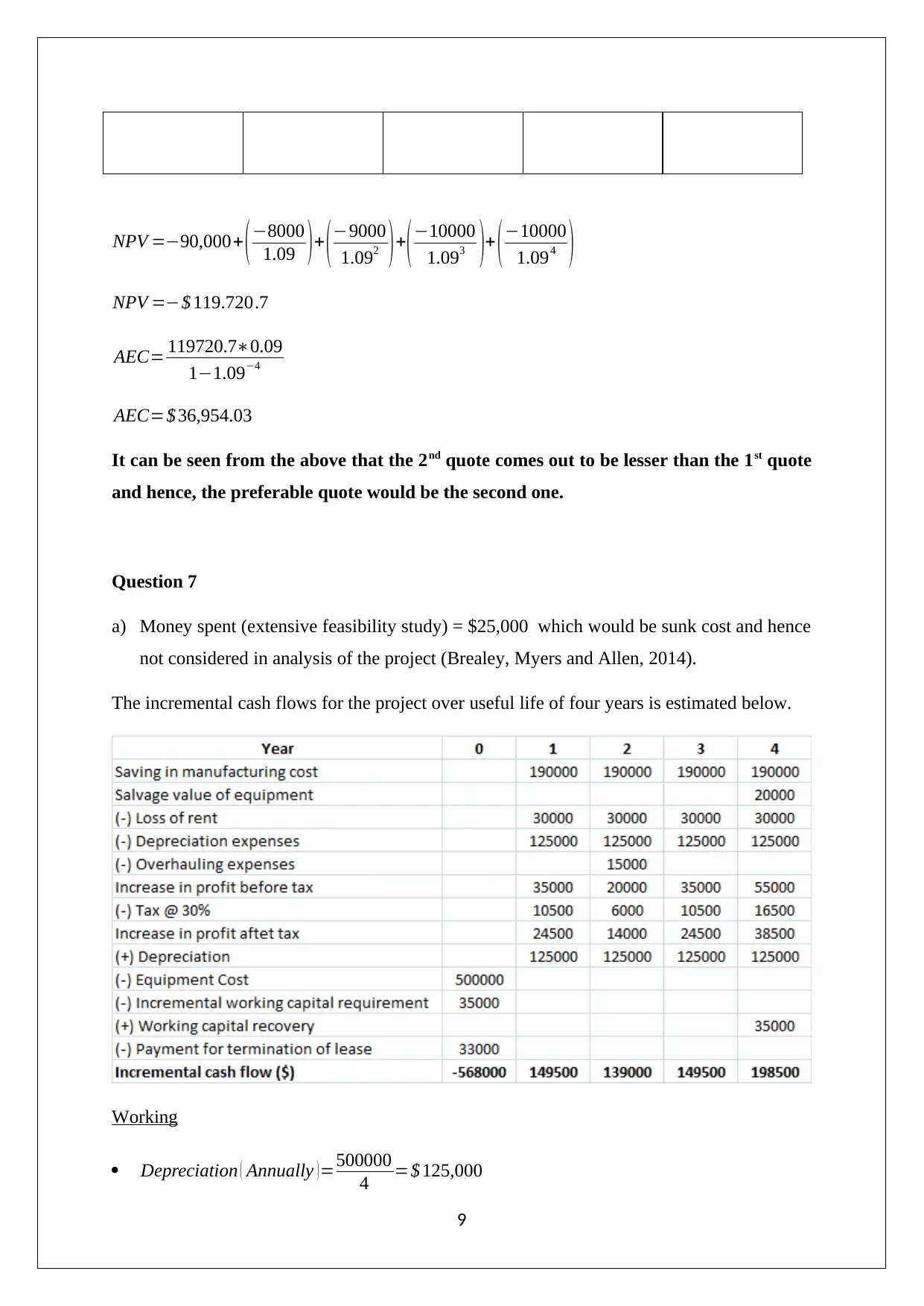
NPV =−90,000+ (−8000
1.09 )+ (−9000
1.092 )+
(−10000
1.093 )+ (−10000
1.094 )
NPV =−$ 119.720.7
AEC= 119720.7∗0.09
1−1.09−4
AEC=$ 36,954.03
It can be seen from the above that the 2nd quote comes out to be lesser than the 1st quote
and hence, the preferable quote would be the second one.
Question 7
a) Money spent (extensive feasibility study) = $25,000 which would be sunk cost and hence
not considered in analysis of the project (Brealey, Myers and Allen, 2014).
The incremental cash flows for the project over useful life of four years is estimated below.
Working
Depreciation ( Annually )=500000
4 =$ 125,000
9
1.09 )+ (−9000
1.092 )+
(−10000
1.093 )+ (−10000
1.094 )
NPV =−$ 119.720.7
AEC= 119720.7∗0.09
1−1.09−4
AEC=$ 36,954.03
It can be seen from the above that the 2nd quote comes out to be lesser than the 1st quote
and hence, the preferable quote would be the second one.
Question 7
a) Money spent (extensive feasibility study) = $25,000 which would be sunk cost and hence
not considered in analysis of the project (Brealey, Myers and Allen, 2014).
The incremental cash flows for the project over useful life of four years is estimated below.
Working
Depreciation ( Annually )=500000
4 =$ 125,000
9
⊘ This is a preview!⊘
Do you want full access?
Subscribe today to unlock all pages.

Trusted by 1+ million students worldwide
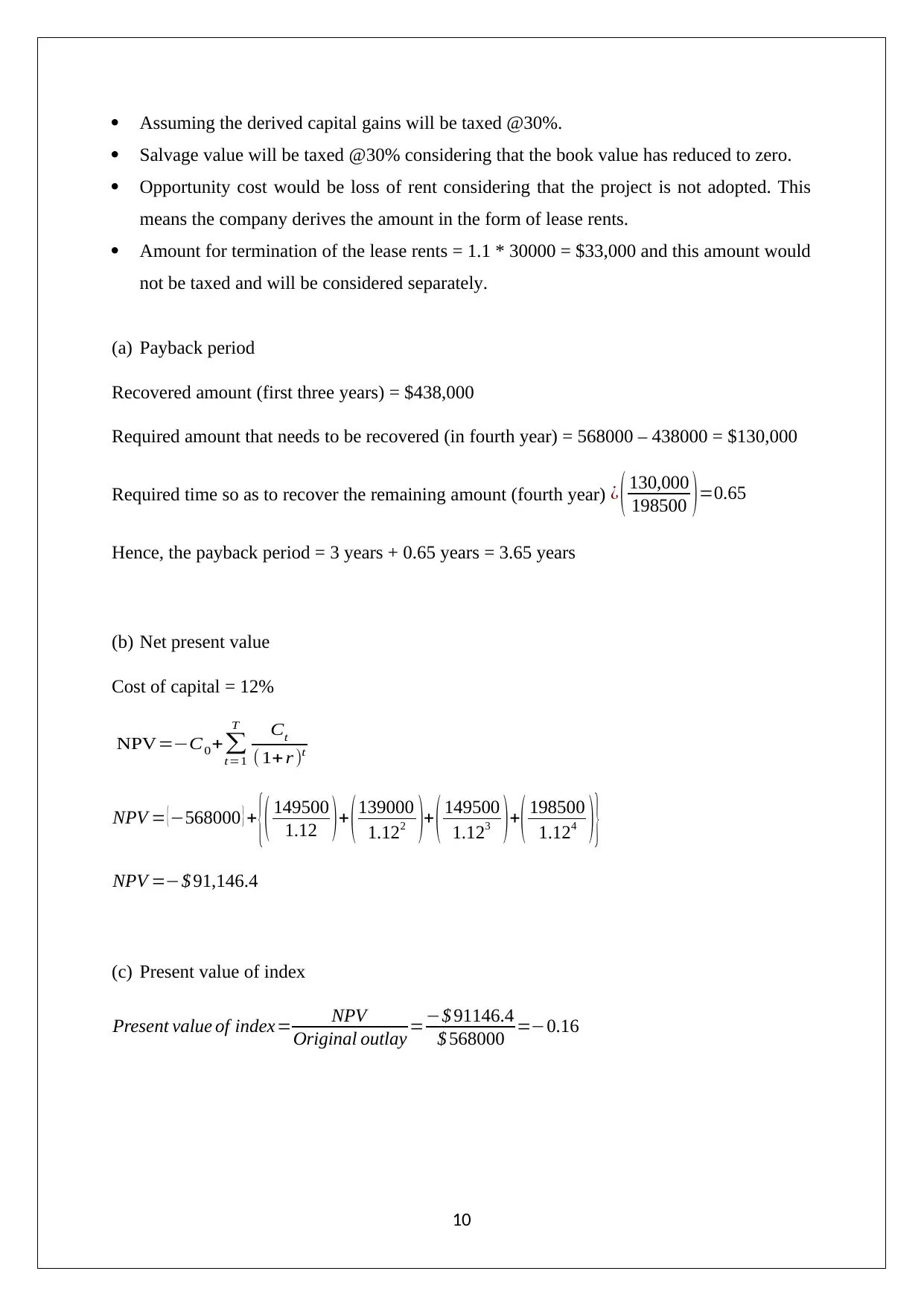
Assuming the derived capital gains will be taxed @30%.
Salvage value will be taxed @30% considering that the book value has reduced to zero.
Opportunity cost would be loss of rent considering that the project is not adopted. This
means the company derives the amount in the form of lease rents.
Amount for termination of the lease rents = 1.1 * 30000 = $33,000 and this amount would
not be taxed and will be considered separately.
(a) Payback period
Recovered amount (first three years) = $438,000
Required amount that needs to be recovered (in fourth year) = 568000 – 438000 = $130,000
Required time so as to recover the remaining amount (fourth year) ¿ ( 130,000
198500 ) =0.65
Hence, the payback period = 3 years + 0.65 years = 3.65 years
(b) Net present value
Cost of capital = 12%
NPV=−C0+∑
t=1
T Ct
( 1+ r )t
NPV = {−568000 } + {( 149500
1.12 ) + ( 139000
1.122 )+ ( 149500
1.123 ) +( 198500
1.124 )}
NPV =−$ 91,146.4
(c) Present value of index
Present value of index= NPV
Original outlay =−$ 91146.4
$ 568000 =−0.16
10
Salvage value will be taxed @30% considering that the book value has reduced to zero.
Opportunity cost would be loss of rent considering that the project is not adopted. This
means the company derives the amount in the form of lease rents.
Amount for termination of the lease rents = 1.1 * 30000 = $33,000 and this amount would
not be taxed and will be considered separately.
(a) Payback period
Recovered amount (first three years) = $438,000
Required amount that needs to be recovered (in fourth year) = 568000 – 438000 = $130,000
Required time so as to recover the remaining amount (fourth year) ¿ ( 130,000
198500 ) =0.65
Hence, the payback period = 3 years + 0.65 years = 3.65 years
(b) Net present value
Cost of capital = 12%
NPV=−C0+∑
t=1
T Ct
( 1+ r )t
NPV = {−568000 } + {( 149500
1.12 ) + ( 139000
1.122 )+ ( 149500
1.123 ) +( 198500
1.124 )}
NPV =−$ 91,146.4
(c) Present value of index
Present value of index= NPV
Original outlay =−$ 91146.4
$ 568000 =−0.16
10
Paraphrase This Document
Need a fresh take? Get an instant paraphrase of this document with our AI Paraphraser
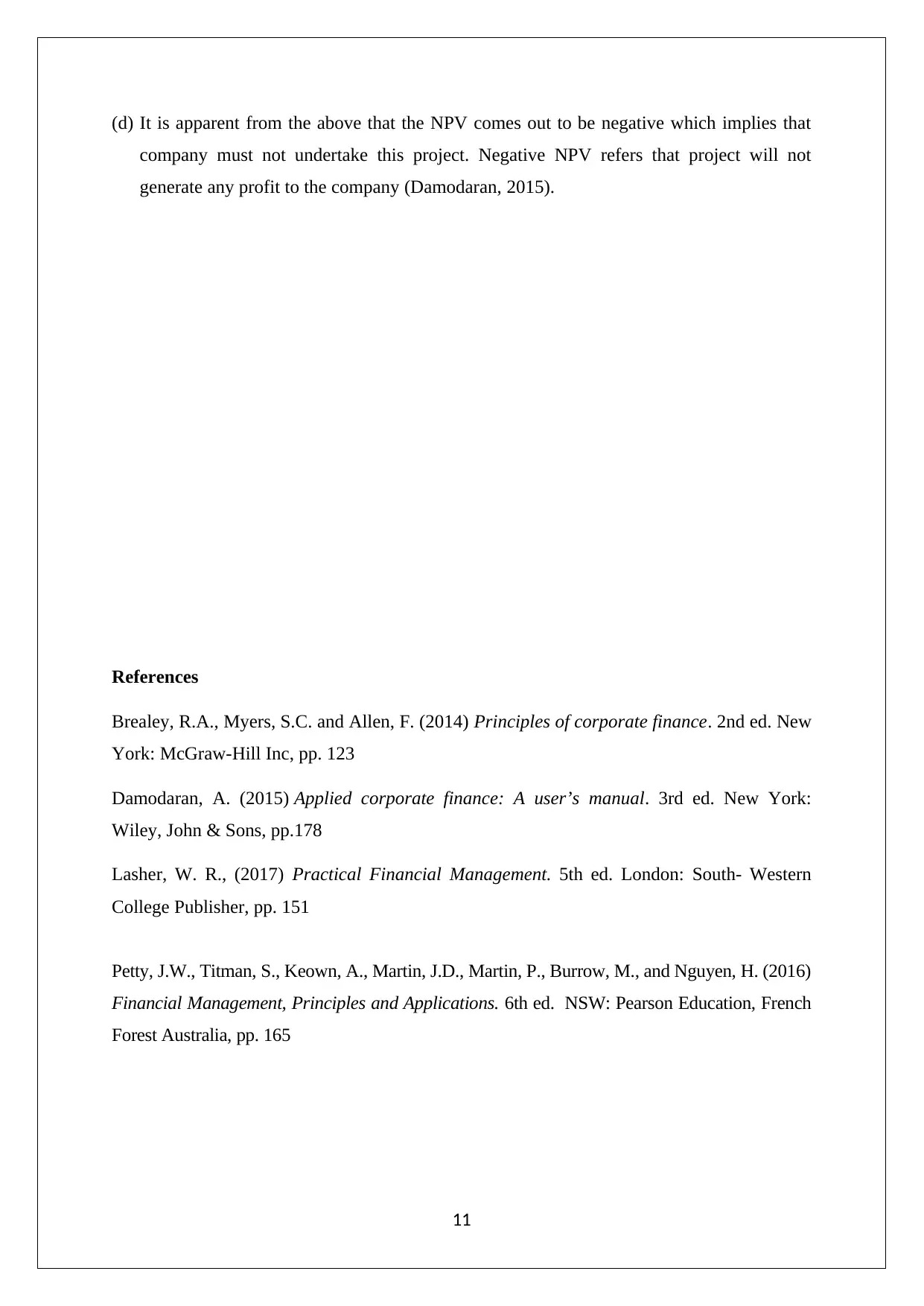
(d) It is apparent from the above that the NPV comes out to be negative which implies that
company must not undertake this project. Negative NPV refers that project will not
generate any profit to the company (Damodaran, 2015).
References
Brealey, R.A., Myers, S.C. and Allen, F. (2014) Principles of corporate finance. 2nd ed. New
York: McGraw-Hill Inc, pp. 123
Damodaran, A. (2015) Applied corporate finance: A user’s manual. 3rd ed. New York:
Wiley, John & Sons, pp.178
Lasher, W. R., (2017) Practical Financial Management. 5th ed. London: South- Western
College Publisher, pp. 151
Petty, J.W., Titman, S., Keown, A., Martin, J.D., Martin, P., Burrow, M., and Nguyen, H. (2016)
Financial Management, Principles and Applications. 6th ed. NSW: Pearson Education, French
Forest Australia, pp. 165
11
company must not undertake this project. Negative NPV refers that project will not
generate any profit to the company (Damodaran, 2015).
References
Brealey, R.A., Myers, S.C. and Allen, F. (2014) Principles of corporate finance. 2nd ed. New
York: McGraw-Hill Inc, pp. 123
Damodaran, A. (2015) Applied corporate finance: A user’s manual. 3rd ed. New York:
Wiley, John & Sons, pp.178
Lasher, W. R., (2017) Practical Financial Management. 5th ed. London: South- Western
College Publisher, pp. 151
Petty, J.W., Titman, S., Keown, A., Martin, J.D., Martin, P., Burrow, M., and Nguyen, H. (2016)
Financial Management, Principles and Applications. 6th ed. NSW: Pearson Education, French
Forest Australia, pp. 165
11
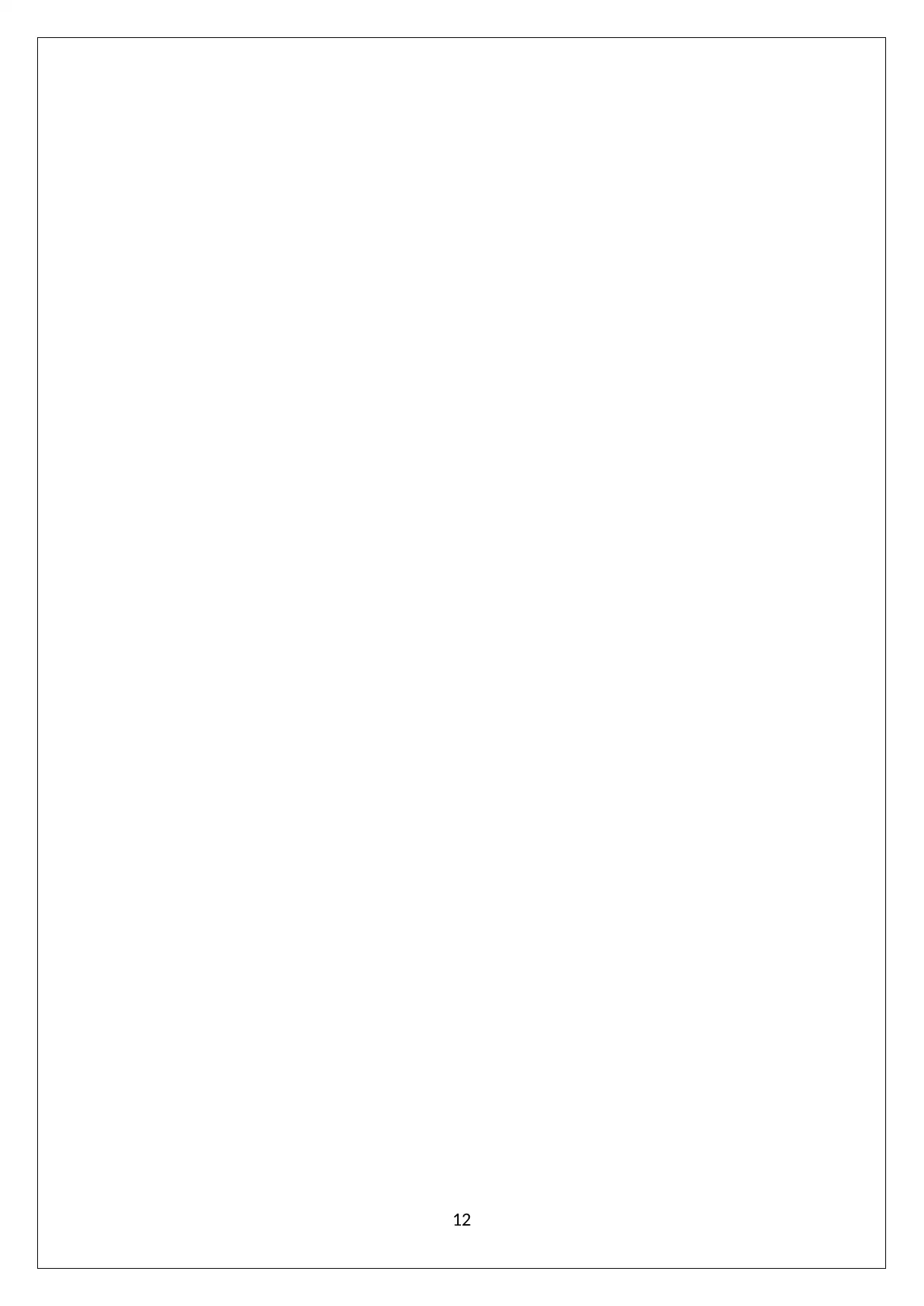
12
⊘ This is a preview!⊘
Do you want full access?
Subscribe today to unlock all pages.

Trusted by 1+ million students worldwide
1 out of 13
Your All-in-One AI-Powered Toolkit for Academic Success.
+13062052269
info@desklib.com
Available 24*7 on WhatsApp / Email
![[object Object]](/_next/static/media/star-bottom.7253800d.svg)
Unlock your academic potential
Copyright © 2020–2026 A2Z Services. All Rights Reserved. Developed and managed by ZUCOL.
